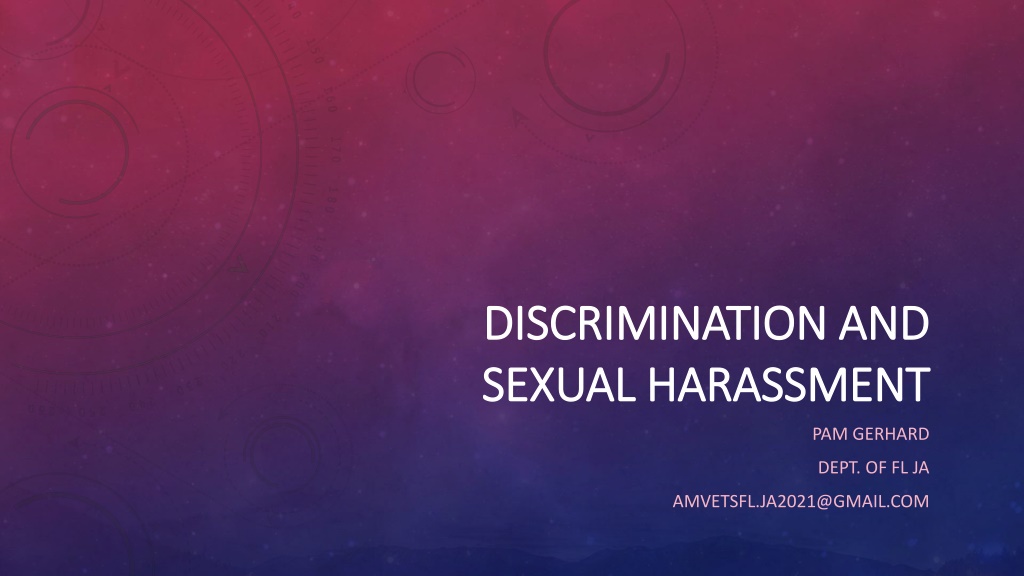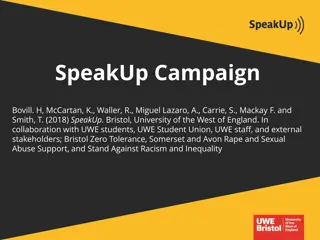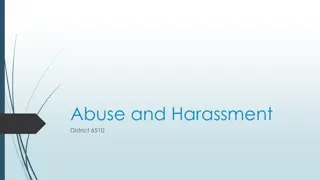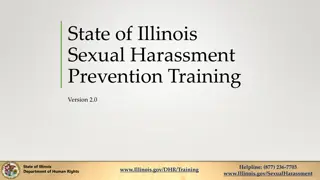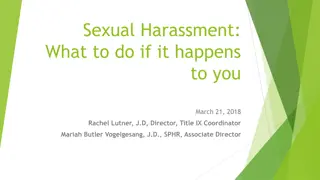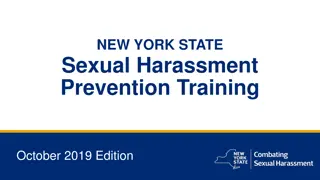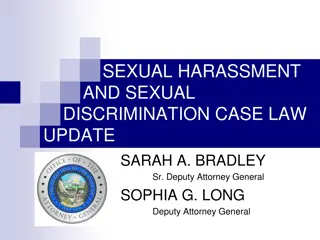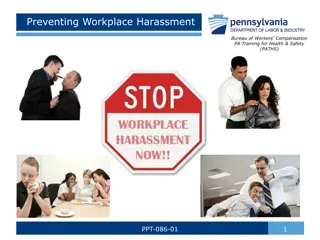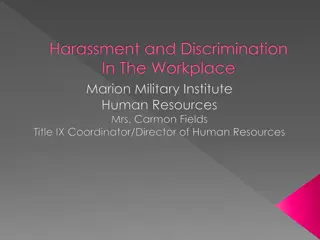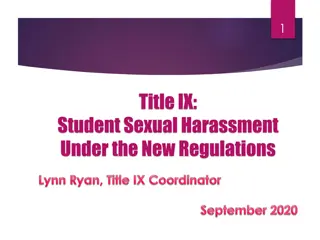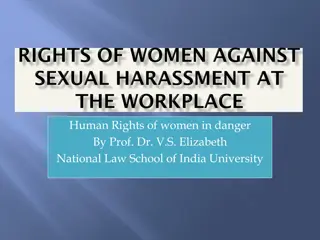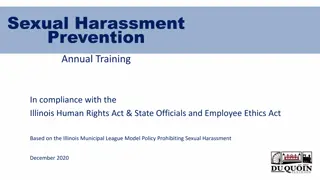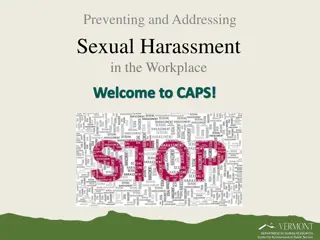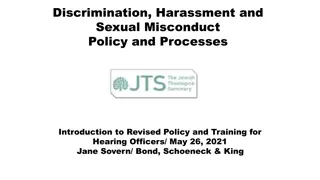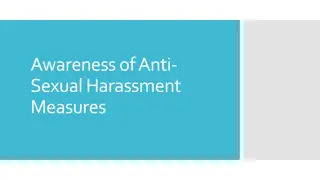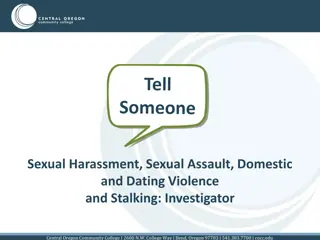Understanding Discrimination and Sexual Harassment Policy in AMVETS
This content provides insights into the policy and definitions of discrimination, sexual harassment, and examples within the context of AMVETS organization. It explains the prohibited behaviors, such as gender-based harassment, and outlines the scope of the policy in addressing discrimination based on sex, age, race, national origin, sexual orientation, marital status, and membership in other activities. Additionally, it delves into the definitions of discrimination and sexual harassment according to Webster, shedding light on the various connotations and implications associated with these terms.
Download Presentation

Please find below an Image/Link to download the presentation.
The content on the website is provided AS IS for your information and personal use only. It may not be sold, licensed, or shared on other websites without obtaining consent from the author. Download presentation by click this link. If you encounter any issues during the download, it is possible that the publisher has removed the file from their server.
E N D
Presentation Transcript
DISCRIMINATION AND DISCRIMINATION AND SEXUAL HARASSMENT SEXUAL HARASSMENT PAM GERHARD DEPT. OF FL JA AMVETSFL.JA2021@GMAIL.COM
AGENDA Definition Policy Examples Summary
WHAT IS AMVETS POLICY AMVETS PROHIBITS HARASSMENT OF ITS EMPLOYEES OR OTHER MEMBERS. THIS POLICY APPLIES TO SUPERVISORS, COWORKERS, CUSTOMERS, OR SUPPLIERS.
WHAT IS CONSIDERED DISCRIMINATION IN AMVETS Sex Age Race National Origin Sexual Orientation Marital Status Membership in Other Activities
WHAT IS DISCRIMINATION OR SEXUAL HARASSMENT According to Webster Discrimination: Has senses with neutral, positive, and negative connotations. On the one hand, it can refer to "the act (or power) of distinguishing" or to "good taste, refinement." These meanings, sometimes reinforced with modifiers (as in fine or nice discrimination), stress an ability to perceive differences as an index of unusual intelligence. On the other hand, when the perception of difference is marked by invidious distinction or hostility, the word (often followed by against) takes on very negative overtones, as in the sense "act of discriminating categorically rather than individually" (discrimination against women, age, sexual orientation discrimination) and "a prejudiced outlook or course of action" (racial discrimination).
WHAT IS DISCRIMINATION OR SEXUAL HARASSMENT According to Webster sexual harassment: uninvited and unwelcome verbal or physical behavior of a sexual nature especially by a person in authority toward a subordinate (such as an employee or student)
EXAMPLES OF DISCRIMINATION/ HARRASSMENT Gender: Gender-based harassment is unwelcome conduct based on someone's actual or perceived sex. It can include a variety of behaviors, such as: Verbal harassment Using derogatory names, slurs, taunts, or stereotypes Physical harassment Unwanted touching, invading personal space, or making gender-motivated physical threats or attacks
EXAMPLES OF DISCRIMINATION/ HARRASSMENT Gender: Online harassment Sharing sexual images, cyber pornography, or non-consensual intimate images or videos Harassment based on gender identity Using the wrong name or gender pronouns, shaming someone for not dressing or acting in a certain way, or refusing to allow someone to use the restroom associated with their gender identity Harassment based on sex roles Making comments about someone's appearance or mannerisms, bullying someone using gender- related comments, or treating someone badly because they don't conform to sex-role stereotypes
EXAMPLES OF DISCRIMINATION/ HARRASSMENT AGE: Age harassment, or age discrimination, is any unwanted conduct that violates a person's dignity or creates an offensive environment based on their age. It can include verbal or physical conduct, such as: Offensive remarks: Derogatory comments, age-based jokes, or slurs Negative stereotypes: Remarks that reflect a preference for younger workers or view older people as less productive Hostility: Cornering comments or nicknames that pressure someone to retire Gestures: Offensive cartoons, drawings, or symbols
EXAMPLES OF DISCRIMINATION/ HARRASSMENT RACE: People can experience racial discrimination in a variety of different ways. In its most overt form, racial discrimination can occur as a result of stereotyping, prejudice and bias. Racial discrimination also occurs in large measure through subtle forms of differential treatment. Prejudice and overt bias Racial discrimination may occur because of overt prejudice, hostility or negative feelings held by someone about a racialized person or group. Unfortunately, people are still treated unequally, such as by being refused a job or apartment, simply because of overt bias towards them based on race and related grounds. Stereotyping In addition, people may experience racial discrimination because of stereotyping. Stereotyping typically involves attributing the same characteristics to all members of a group, regardless of individual differences. It is often based on misconceptions, incomplete information and/or false generalizations. In most cases, stereotypes assume negative characteristics about a group. Even those who are well meaning and not overtly biased can nevertheless stereotype.
EXAMPLES OF DISCRIMINATION/ HARRASSMENT RACE: Racial profiling Racial profiling is a form of stereotyping that has particular implications for racialized persons. The Commission has defined racial profiling as any action undertaken for reasons of safety, security or public protection that relies on stereotypes about race, color, ethnicity, ancestry, religion or place of origin rather than on reasonable suspicion, to single out an individual for greater scrutiny or different treatment. Race only needs to be a factor in the conduct alleged to constitute profiling. Some considerations that help determine whether racial profiling occurred include: Statements that indicate stereotyping or prejudice such as racial comments; A non-existent, contradictory or changing explanation for why someone was targeted
EXAMPLES OF DISCRIMINATION/ HARRASSMENT RACE: The situation unfolded differently than if the person had been White; or Deviations from normal practices or an unprofessional manner. Subtle forms of racial discrimination Subtle and subversive discrimination has also been identified as one of the most common ways racialized people experience unequal treatment. Subtle forms of discrimination can often only be detected upon examining all of the circumstances. As well, contrasting how a racialized person was treated with how others were treated in a comparable situation, or looking for patterns of behavior will help to determine whether subtle discrimination was at play. While comments about race may sometimes be made, this is not necessary for a finding that subtle racial discrimination has occurred. Racial discrimination need only be one of the reasons for the treatment received. There are many examples of subtle forms of racial discrimination. In employment, it can take the form of failing to hire, train, mentor or promote a racialized person. Racialized persons may find themselves subjected to excessive performance monitoring or maybe more seriously blamed for a common mistake. And, normal differences of opinion or failing to get along with a co-worker may be treated as more serious when a racialized person is involved. Subtle racial discrimination can occur in a variety of other contexts as well. In housing, racialized persons may be turned away as tenants, or may not be granted equal access to maintenance and repairs. Issues also arise in services and facilities including malls, restaurants, movie theatres, education services, and healthcare services.
EXAMPLES OF DISCRIMINATION/ HARRASSMENT Nationality National origin harassment is offensive or unwelcome behavior based on a person's ethnicity or place of origin. It can include verbal or physical conduct, such as: Ethnic slurs, Jokes, Offensive or derogatory comments, and Workplace graffiti.
EXAMPLES OF DISCRIMINATION/ HARRASSMENT Sexual Orientation Harassment based on sexual orientation is any conduct that creates a hostile, offensive, or intimidating work environment and is motivated by a protected category, such as sexual orientation. Some examples of sexual orientation harassment include: Verbal harassment Offensive jokes or comments, homophobic slurs, name-calling, or derogatory remarks about a person's sexual orientation or gender transition Physical harassment Unwelcome touching, sexual gestures, physical assault, or invading personal space
EXAMPLES OF DISCRIMINATION/ HARRASSMENT Sexual Orientation Written harassment Insensitive statements about how a person has sex with their partner, or posting an offensive picture in an employee's workspace Other harassment Degrading a gay person because they don't conform to traditional views on how men and women should look, dress, or behave, or denying access to a bathroom or other sex- segregated facility consistent with the individual's gender identity
EXAMPLES OF DISCRIMINATION/ HARRASSMENT Marital Status Marital status harassment is when someone is treated poorly due to their marital status, and it can occur in many different relationships. It can be severe, pervasive, or persistent enough to create a hostile environment. Some examples of marital status harassment include: In the workplace Denying a promotion to a single employee because they are presumed to be less stable than married colleagues, making derogatory comments about a divorced coworker, or denying certain benefits to employees based on their marital status In other relationships A landlord refusing to rent to domestic partners, a jockey club refusing to grant a trainer's license to someone because their husband has been convicted of betting fraud, or a dance studio offering tango lessons only to people who are single.
EXAMPLES OF DISCRIMINATION/ HARRASSMENT Membership in Other Activities Clubs
SUMMARY Discrimination/ Harassment can take many forms. Be careful not to be the one guilty of discrimination or harassment in any form. You will be brought up on charges if it is found that you have done any of what has been discussed today. This could result in various punishments not limited to punishment within AMVETS but also civil punishments as well.
THANK YOU! PAM GERHARD AMVETSFL.JA2021@GMAIL.COM
